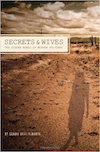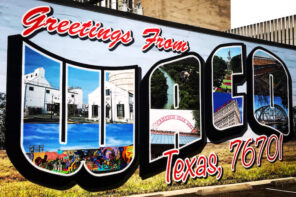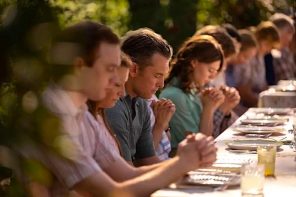What inspired you to write Secrets & Wives: The Hidden World of Mormon Polygamy? What sparked your interest?
I’m one of those unbelievers who’s obsessed with religion, so moving to America from England was a bargain. The Bush presidency was underway, the Christian right were on the march, and the country was going down the tubes so fast you could hear a sucking sound.
But I was only peripherally aware of Mormons. I remember the polygamist Tom Green appearing on Jerry Springer once with his harem, but it wasn’t till Jon Krakauer’s book Under The Banner of Heaven came out that I started paying attention. And right on cue, Warren Jeffs, the prophet of the FLDS, went off the deep end in epic style—he banned laughter and the color red and set about building a giant temple in Texas with the FBI in hot pursuit. There are few things I find more entertaining than a cult leader going clear off the reservation.I’ve always been drawn to outsiders and fringe groups—people who stand apart from the mainstream. So the mere existence of a subculture of 40,000 fundamentalists living outside the law in America struck me as tremendously exciting. Not to mention the fact that their faith is American—it could scarcely be more so—and yet they live in hiding, worshipping at secret churches with scores of secret wives. I couldn’t resist.
I wrote a few articles and made a documentary, all of which focused on Warren Jeffs and the FLDS, as most media coverage still does. But it soon became clear that the FLDS was just one group. There were 30,000 other polygamists out there: a broad diaspora of smaller churches and independents that remained discreetly marbled into the populations of Utah and Arizona especially. What were they hiding? Was hiding really necessary? Would they open up to me if I asked nicely? That’s how Secrets & Wives began.
What’s the most important take-home message for readers?
There are a few. That Utah is bubbling over with self-declared prophets and messiahs—the Mormon religion is strong potion. That the illegality of polygamy is a boon to cult leaders who wish to control their flocks and commit sex crimes with impunity.
And most of all, that not all polygamists are alike. Attitudes seem to have shifted lately from suspicion to sympathy; many now see polygamists as victims of persecution who ought to be left alone. But this is as insufficient as the opposite view that polygamists are sinister deviants who must be prosecuted. The truth is more complex. Certainly, some groups like The Order, did strike me as sinister—the practice of incest, for instance, or of changing surnames to mask identity, not to mention the allegations of child labor and underage marriages. No question about it, there are shocking stories of abuse within fundamentalism. But equally, some groups are comparatively benign and more inclined to open up to outsiders.
I believe it’s time to decriminalize polygamy and bring these people out of the darkness. Too many awful things happen in the dark.
Anything you had to leave out?
Some stories were cut for length. The story of a liberal businesswoman from the Bay Area for instance, who fell in love with a younger fundamentalist carpenter and became his second wife. Her mom was a hippie and now she lives in an exclusively polygamist community in Arizona. That’s one of them.
What are some of the biggest misconceptions about your topic?
That polygamy is somehow drab or dismal, a bunch of oppressed women in prairie dresses doing household chores and suckling babies, often at the same time. But that’s not the case. (Not completely anyway—there’s bound to be some oppression and suckling going on.) The truth is, polygamy is intense. It’s a cauldron. Much stranger and richer than Big Love or Sister Wives.
This is a world in which men converse with God, the stakes are eternal, the apocalypse is imminent and no one “out there” can be trusted. It’s all belief and longing and paranoia. All the dials are turned up to 11—there’s more risk, more conflict, more drama. It’s a world where a few men have over 100 children apiece. One guy has over 250. Drab doesn’t get a look in.
I was often shocked on my travels. I never imagined that polygamists would get me drunk on margaritas, for example. Or that fundamentalist children would have started a Bollywood movie club. Or that way out in the Moab desert there is a polygamous community that inhabits a giant rock powered by solar panels. For all their faults, which are many, fundamentalists have a point when they say that Mormonism lost its most colorful characters when it abandoned polygamy.
Did you have a specific audience in mind when writing?
As a topic, polygamy appears to have a very broad appeal, so I’m hoping Secrets & Wives will too. I wrote it for anyone who’s interested in American religion, Mormonism in particular, the religion of Mitt Romney and Glenn Beck; in how modern polygamists actually live and why; in prophets and followers and the dynamics of cults; in child brides and women’s rights; and in how a subculture of zealots might respond to an English atheist with a funny name asking deeply personal questions.
Are you hoping to just inform readers? Give them pleasure? Piss them off?
Pissing people off was never a mission objective, though I doubt Mormons will be rushing out to buy copies for their friends. But to inform and entertain? Absolutely.
This is a first-person exploration of polygamous groups and the issues they raise, and I always thought of the reader as my traveling companion as I went around Utah knocking on doors. Sometimes things didn’t go according to plan. While some groups invited me to stay over for weeks on end, others threw me out into the street. And occasionally, I would stumble across some drama or intrigue that sucked me right in.
But however the adventure unfolded, that’s how it is told—I stayed true to the rollercoaster. And that goes for tone too. Polygamy is certainly rich in heartbreaking stories and serious issues, but there were also funny moments along the way. So I’m actually hoping that readers will laugh uproariously in some places and weep sweet tears in others. And world peace would be nice.
What alternate title would you give the book?
We toyed with titles and taglines till the cows came home, but I think we chose wisely in the end. Here are a few options that didn’t make the cut: “To Be A God: The Secret Lives of Polygamists”, “When One Won’t Do: The Hidden World of Mormon Polygamy”, “First You Get The Wives, Then You Get The Planet: The Things I Learned About Polygamists During My Summer In Utah”, and “Mormon Polygamy: A Gentile Investigates”.
How do you feel about the cover?
I love it. I feel very lucky. Briar Levit is the designer and she’s managed to perfectly evoke a hidden people, a life in the shadows. There’s a wife standing there but we can’t see her, her identity is concealed, she’s a secret. And look at those dramatic skies ahead of her. That’s polygamy: a gathering storm in the desert.
Is there a book out there you wish you had written? Which one? Why?
Harry Potter and the Philosopher’s Stone, for obvious reasons. But also Jeff Sharlet’s The Family—impeccably researched, expertly constructed and of lasting importance. Simply the best and most frightening expose of the Christian Right in America. I’m also envious of Sam Harris whose book, The End of Faith, was a brilliant blast of dissent at a time when religion appeared to be on the rampage in America.
What’s your next book?
There are a few ideas cooking but I don’t want to say too much. I might be an atheist but I believe in jinxing.
Correction: The book designer’s name has been corrected to Briar Levit, 4/24/11 -Eds.





